Captions Exhibition
Jeremy Hunter Let’s Celebrate 365
Jupiter 15. April – 13. May 2023

KONYA, TURKEY
The Sema, or Mevlevi Ceremony
Date: 2005
Format: 35mm film
The ‘Whirling’ Ceremony is a means of freeing the Dervish from earthly bondage but the ultimate purpose of the ceremony is to effect a union with God.
Each Dervish can ‘whirl’ for at least 20 minutes.
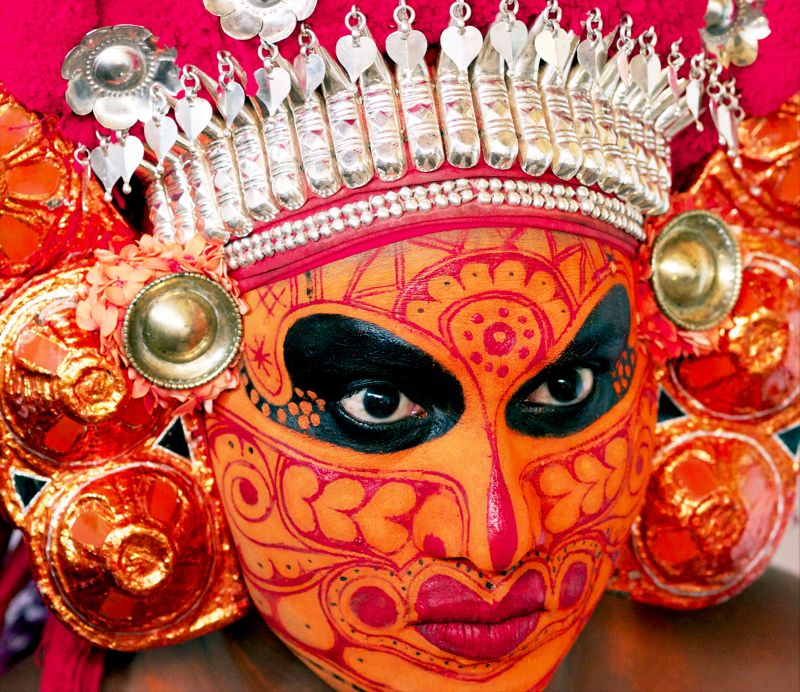
KANNUR, KERALA, INDIA
Theyyam
Date: 2014
Format: Digital
Believed to pre-date Hinduism, Theyyam is said to be a corrupted form of the word ‘Deivam’ meaning God and ‘Aattam’ meaning dance. The meaning of Theyyam thus becomes ‘God’s dance’. It’s a religious dance-drama performed by the Dalits, the ‘Untouchable’ Class.
The Dalit’s, who are the lowest caste in India, perform the most anti-social jobs in the country such as road-sweeping, collecting garbage and cleaning sewers. Yet during the Theyyam season they give up these jobs and metamorphose into Gods.
They will not eat meat or fish, and are forbidden to sleep with their wives. Theyyam artistes are always male. The right to become a Theyyam is always inherited from the Theyyam mother’s family.
Through their mother they have the inherited right to perform, the inherited ‘know-how’ to sing, to dance with the drum, and to do the complicated make-up.
After donning the elaborate costume, their head-dress is finally put on, at which point the Theyyam sees the reflection of himself in a hand-mirror, for the first time.
An all-male orchestra of drummers commence and as the beat gets ever louder and faster, the Theyyam enters a trance-like state for what he sees in the mirror is not his own image, but that of the powerful deity into which he has metamorphosed and now represents; he is an incarnation either of Brahma, Vishnu or Shiva.
Now transformed, almost magically, into a God, villagers of the highest caste in the land – Brahmin’s – queue up to touch the Theyyam’s feet, to worship him, to receive his blessings, to give him offerings and to ask him to grant their wishes or to exorcise the evil spirits.
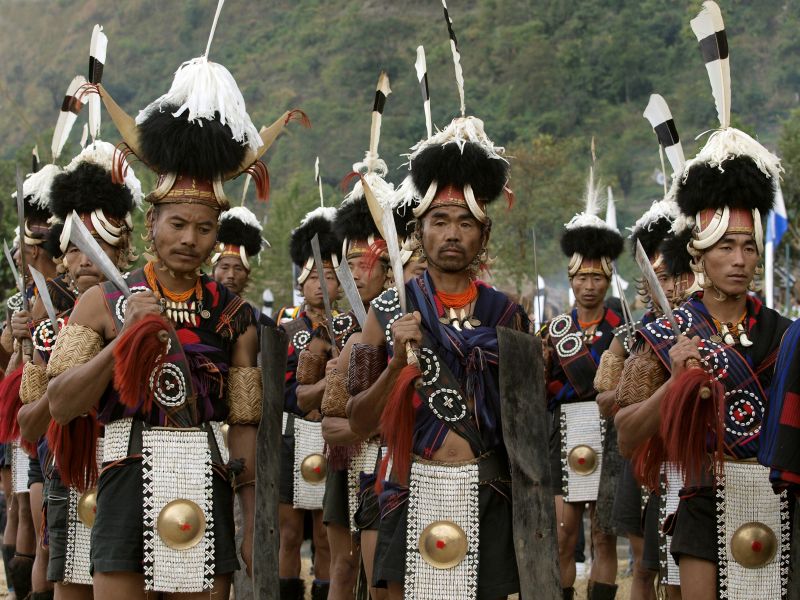
KISAMA, NAGALAND, North East India bordering China, Bhutan, Myanmar, Bangladesh
Hornbill Festival
Date: 2008
Format: Digital
The men-folk of Nagaland were Head-Hunters up until 1990. Indeed the Right-of-Passage for a young man required him to “take a head” and most tribal villages incorporate life-size carvings of severed heads at the village entrance.
Today, 95% of the population practice Christianity which was introduced by Baptists during the early part of the 19th century. Unlike Hindu’s they eat beef and want independence from India.
All the seventeen tribal groups within the country are invited to attend the week-long Hornbill Festival which was created by the Government in 2000 to encourage inter-tribal interaction.

PRAYAG, NEAR ALLAHABAD, UTTAR PRADESH, INDIA
Maha Kumbh Mela
Date: 2001
Format: 35mm film
This festival is celebrated once every 12 years and has been taking place for around 3000 years. This is a Hindu festival – and there are 1.2 billion Hindu’s worldwide.
In 2001 up to 70 million of these are estimated to have attended the forty-two days of religious pilgrimage intertwined with carnival that is the Maha Kumbh Mela, the Great Festival of Elixir celebrating the triumphant recovery of the Nectar of Immortality.
Young boys, attired in the most opulent and lavish of ceremonial costumes, take on a temporary gender change during the Kumbh and are worshipped as living female Goddesses.
Their feet are not allowed to touch the ground and they are carried everywhere by their fathers or guardians.
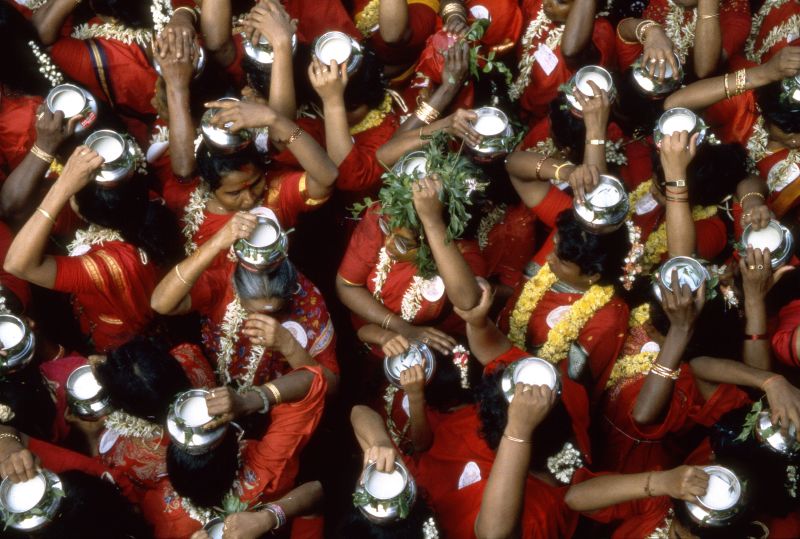
KUALA LUMPUR, MALAYSIA
Tamil Festival of the Goddess Amman
Date:1996
Format: 35mm film
For the Tamils, the Goddess Amman is their special protector and benefactor, and over the centuries the Goddess has provided them with protection from sickness.
Starting at dawn, the Tamils set off for the temple, balancing on their heads brass jugs containing their offerings of sustenance – fresh milk – with which to anoint, behind closed doors in the Temple, the image of the Goddess, the Guardian of the Earth.
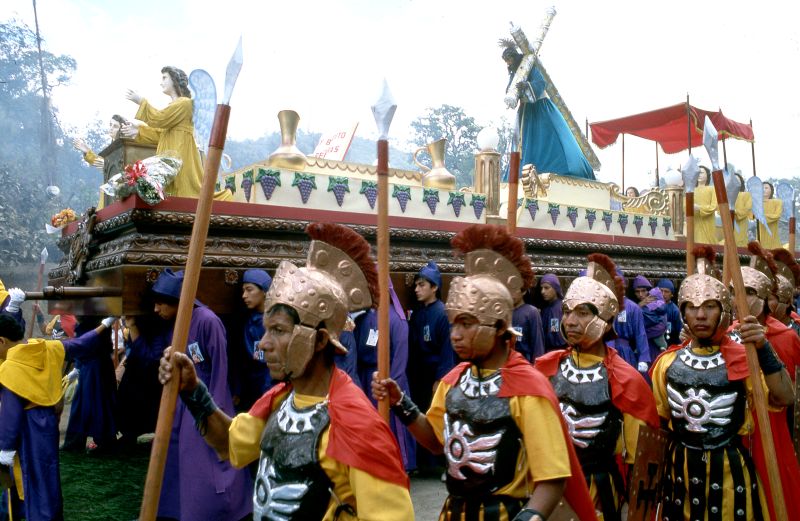
ANTIGUA GUATEMALA
Good Friday Celebrations
Date:1989
Format: 35mm film
As the anda which bears the life-size figure of Christ is carried by Roman Centurions along the streets of Antigua the ancient capital of Guatemala, the scene is reminiscent of a lavish biblical epic – but predates Hollywood by thousands of years.
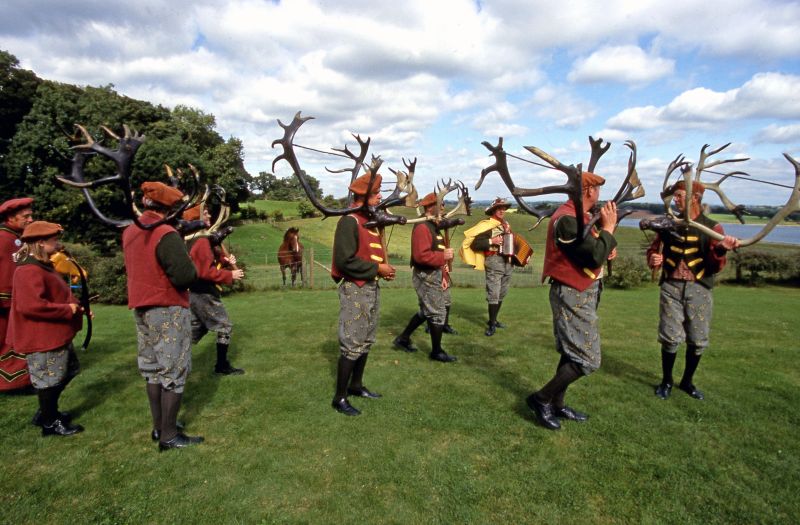
ABBOTS BROMLEY, STAFFORDSHIRE, ENGLAND
Abbots Bromley Horn Dance
Date: 2002
Format: 35mm film
Abbots Bromley in Staffordshire is the venue for a strange Pagan-Christian festival dating from the 13th century – the Horn Dance.
This is an ancient fertility celebration, believed to be part of a pagan hunting ritual.
For one day, the dancers carry around the countryside six pairs of enormous Reindeer horns of great antiquity, which have been carbon dated to 1065 at around the time of the Norman Conquest.
There are references in the Bible to the wearing of deer horns – as a sign of great strength.
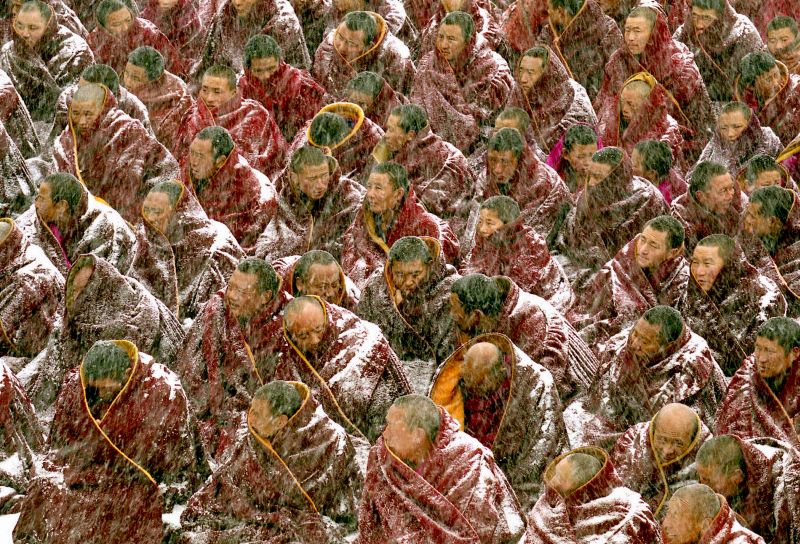
LABRANG, AUTONOMOUS REGION OF EAST TIBET
Grand Summons of the Labuleng Monastery, the Great Monlam Festival, heralding the Tibetan New Year
Date: 2001
Format: 35mm film
At an altitude of nearly 3000 metres in the spectacular landscape of the Amdo region, Labrang is a monastic town which is truly a time-capsule where life, and the local customs
can still be witnessed as they were some five hundred years ago. The magnificent Labrang Monastery is one of the six great Gelugpa monasteries in Tibet.
Tsong Khapa, born in the 14th century, was the founder of the Gelug sect of Tibetan Buddhism, a sect ioften referred to today by its more familar name – Yellow Hat Sect.
Tsong Khapa’s importance in Tibetan culture is that from his disciples came the line of the Dalai Lamas, the spiritual leaders of Tibet.
On the third day of the Great Monlam Festival, the Great Debate takes place.The monkhood assemble, sitting in front of the Living Buddha who is presented with hundreds of pieces of folded paper containing messages.
The reading of these takes several hours, during which the monks must remain squatting on the ground.
One year when I attended the Great Debate, the temperature plummeted to -27c. This was then followed by a blizzard through which the monks sat totally impassively – without apparent concern for the icy conditions.
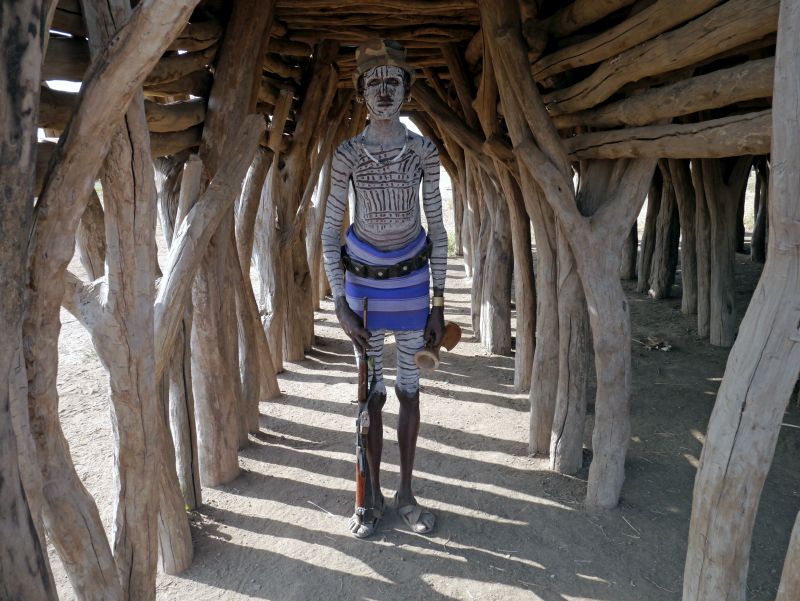
DUSS, LOWER OMO VALLEY, ETHIOPIA
Ceremonial House
Date: 2008
Format: Digital
The Karo tribal group are an endangered people numbering around 1500 in total and are the smallest of the indigenous groups whose livelihood is linked to the flowing of the Omo river.
They are especially noted for their body painting, often referencing the wild animals found in the locality.
This tribal Elder is in the confines of the Ceremonial House, a Council Chamber, into which only men may enter.
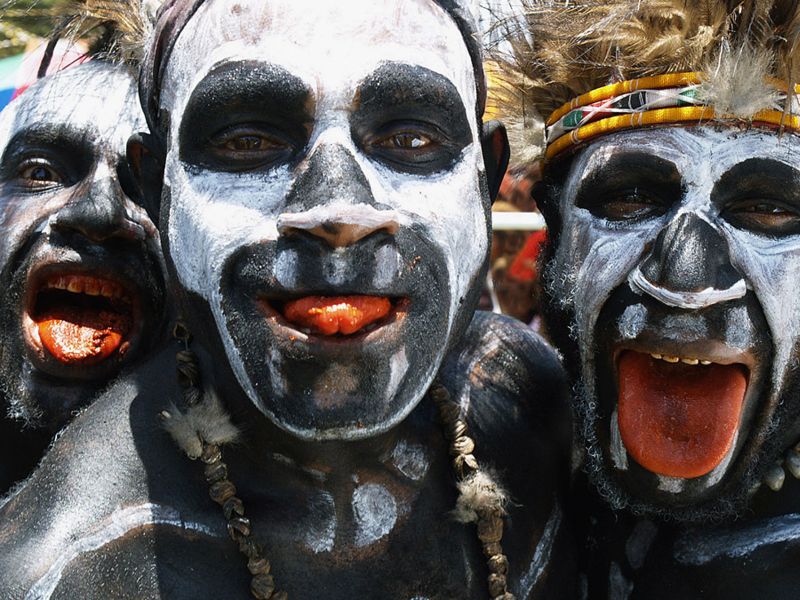
TUMBUNA, PAPUA NEW GUINEA
Sing-Sing
Date: 2007
Format: Digital
A ’Sing-Sing’ is a tribal gathering.
Each group, with their own style of body decoration, travel for days on foot or by boat, bus, or truck to gather for these annual traditional events. Sing Sings are based on traditional large gatherings but these modern festivals were created by the government so that traditional enemies could meet on neutral territory. The first sing-sing was held in the town of Goroka in 1957. Instead of fighting over ancient feuds and cultural differences, the idea was to get together and celebrate diversity and socialize peacefully.
Today it is all about “bigmanship” as this trio from the Sunapi Clan of Chimbu Province demonstrate.
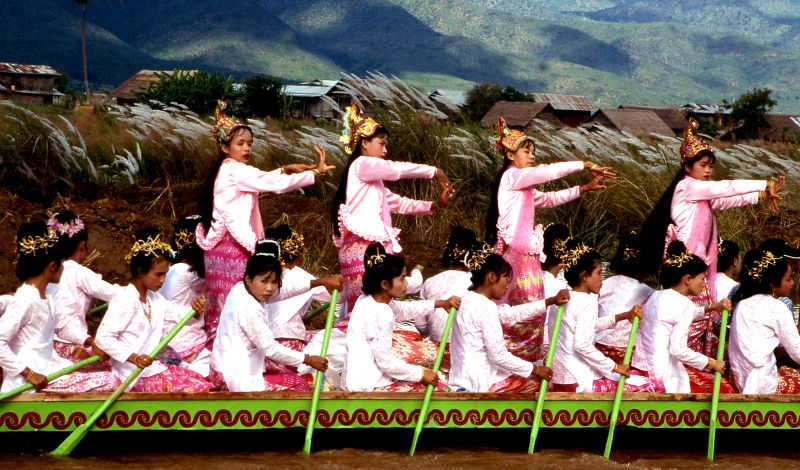
INLE-SEE, MYANMAR (BURMA)
Phaung Daw U Festival
Date: 2001
Format: 35mm film
Despite Myanmar’s appalling abuse of Human Rights, and the unwillingness of the military junta to acknowledge the democratic process, it’s the most beautiful country I have ever travelled through.
The truly spectacular Phaung Daw U festival is celebrated on Lake Inle by the indigeneous Intha (the ‘sons of the lake’) who are believed to have migrated here at the end of the 14th century.
During the festival the Intha travel around the lake in enormously long hley (canoes) which are crewed by one hundred oarsmen.
The objects of the Intha people’s veneration are five short stumpy statues from the 12th century which reside in the Phaung Daw U paya, one of the three most sacred shrines in the country.
The festival provides an opportunity for the Intha to pay homage to these images of the Buddha which are transported daily to a different lake monastery by a huge golden karaweik (or barge) – an ancient ceremonial vessel.
The aquatic procession of the Karaweik is preceeded by an escort of Kachathe dancers (this image) whose performance is an important element as the daily flotilla of boats proceed through the lake to each monastery in turn.
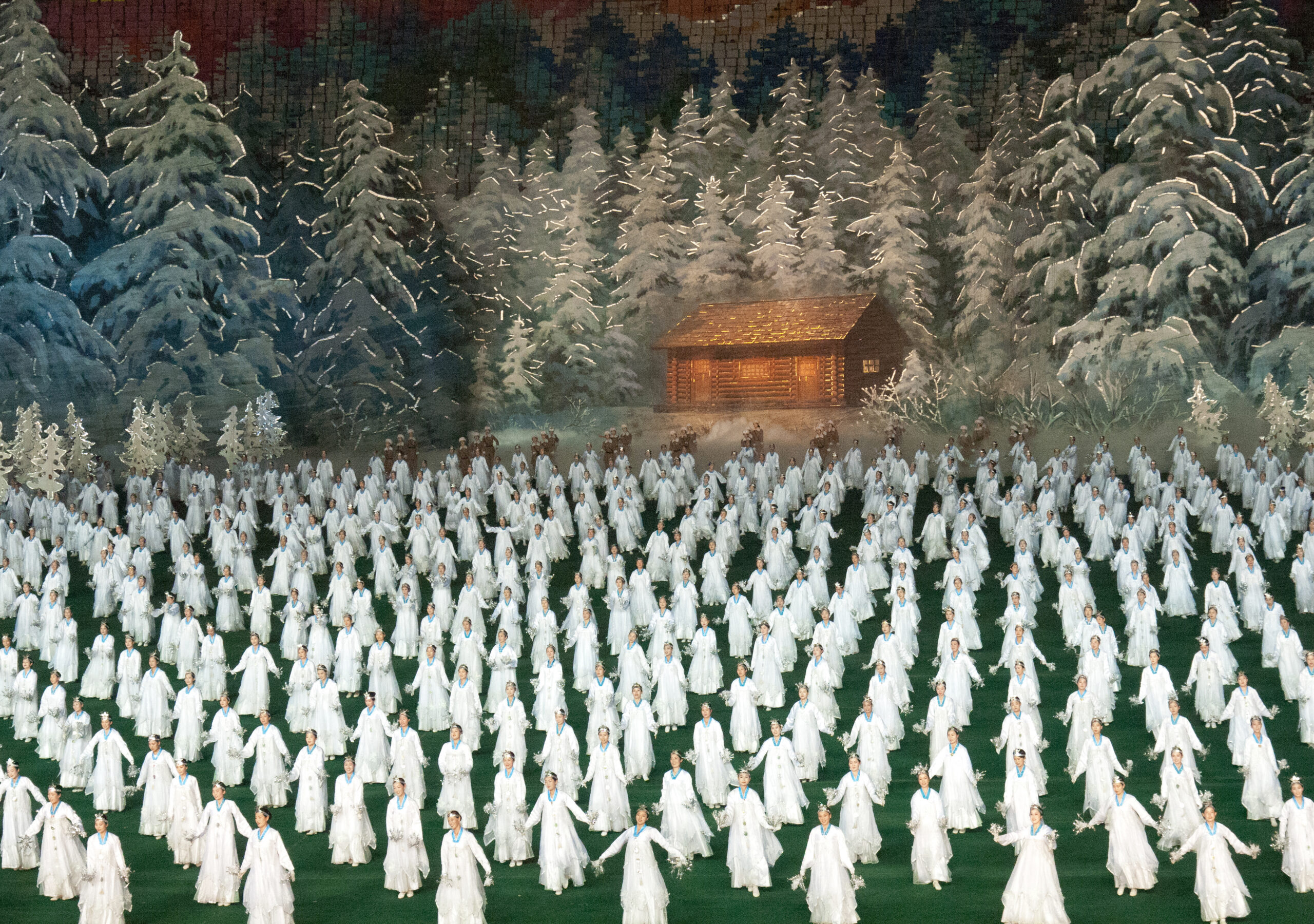
PYONGYANG, NORTH KOREA
Birth-Hut of Kim Jong-il at ARIRANG
Date: 2011
Format: Digital
More than being just a mere name, ARIRANG is an ancient folk song which has come to embody the concept of Korea as a whole, with special interpretations for North Korean politics itself.
During the course of two hours of celebrations, 50,000 participants, utilising hundred of coloured cards, illustrate “the story” of the country.
Its liberation from Japan, the subsequent division of the whole peninsular and the politics of its titular leaders, Kim Il-sung and his son Kim Jong-il.
This is supposedly the birth-place of Kim Jong-il, a wooden hut nestling at the base of Mount Paektu, the most sacred mountain in the whole of the Korean peninsular. Pure propaganda.
Kim Jong-il was born in Vyatskoye in Siberia. His first language was Russian and he did’t live in DPRK until he was seven years old.

MONT ST MICHEL, NORMANDY, FRANCE
Fete de Saint Michel
Date: 2001
Format: 35mm film
The pilgrimage of the Fete de Saint-Michel starts from the village of Genets on the north shore of the baie.
Mont St. Michel le merveile de l’occident was dedicated to St. Michael in 708 by Aubert, Bishop of Avranches, following a series of dreams in which the Archangel ordered him to transform the rock into a place of worship.
For centuries the waters in the bay surrounding the Mount have been the centre of one of the strongest tides in the world. On rare occasions during the year, the tide recedes 16 kms out into the bay.
At the time of this low tide, hundreds of pilgrims walk across the bay, as they have done on major feast days for at least six hundred years, to venerate at the Cathedral, St. Michael – Guardian of the Gates to Paradise.
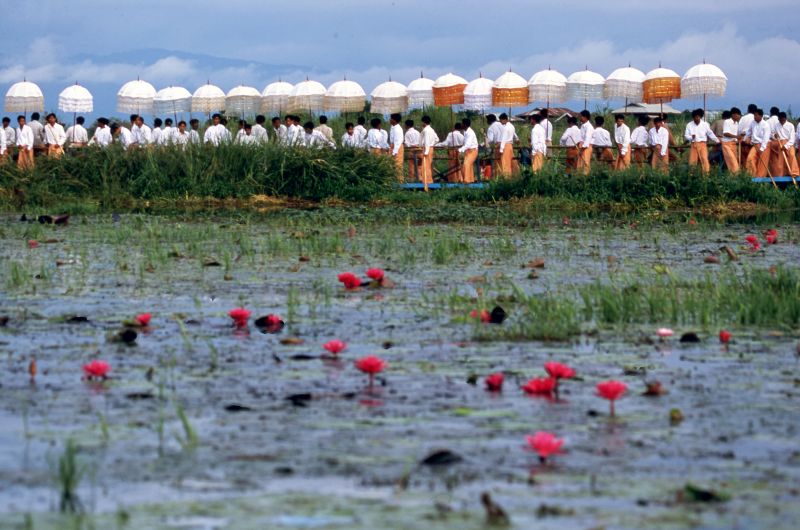
INLE-SEA, MYANMAR (BURMA)
Phaung Daw U Festival
Date: 2001
Format: 35mm film
Despite Myanmar’s appalling abuse of Human Rights, and the unwillingness of the military junta to acknowledge the democratic process, it’s the most beautiful country I have ever travelled through.
The truly spectacular Phaung Daw U festival is celebrated on Lake Inle by the indigeneous Intha (the ‘sons of the lake’) who are believed to have migrated here at the end of the 14th century.
During the festival the Intha travel around the lake in enormously long hley (canoes) which are crewed by one hundred oarsmen.
The objects of the Intha people’s veneration are five short stumpy statues from the 12th century which reside in the Phaung Daw U paya, one of the three most sacred shrines in the country.
The festival provides an opportunity for the Intha to pay homage to these images of the Buddha which are transported daily to a different lake monastery by a huge golden karaweik (or barge) – an ancient ceremonial vessel.

WAGHI VALLEY, WESTERN HIGHLANDS, PAPUA NEW GUINEA
Mudmen
Date: 2007
Format: Digital
To protect themselves from opposing tribal groups who wanted to steal during the darkness of the night their women and pigs (the principal source of wealth in Papua New Guinea),
hill-tribes of the Waghi Valley for centuries adorned themselves with mud and masks in order to look like evil spirits and ghosts.
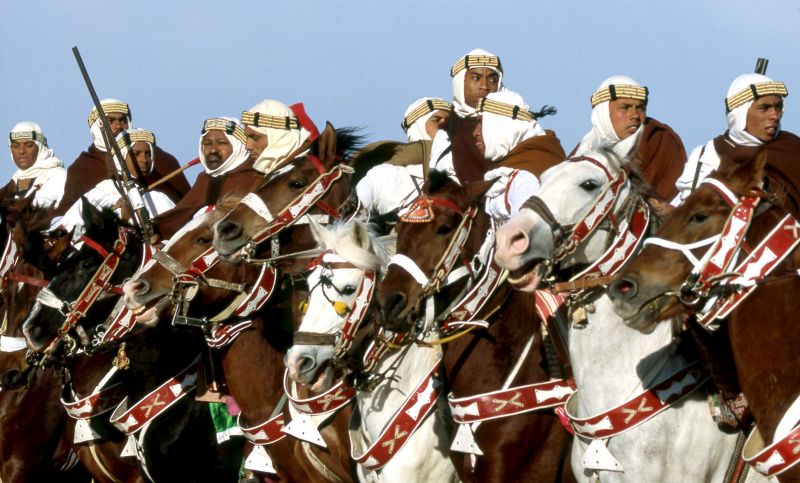
DOUZ, “Gateway to the Sahara”, SOUTHERN TUNISIA
Festival of the Sahara
Date: 2004
Format: 35mm film
This festival was formerly known as La Fete des Dromedaires and is the oldest and most famous Tunisian festival.
It provides a secular opportunity for the tribal Berber of the northern Sahara to celebrate the end of one year and the beginning of the next.
The festival is wholly cinematic in its content and production values. These Berber horsemen have not been exposed to Hollywood or Disney yet this image could have been lifted directly from a Hollywood epic.

LEH, PAPUA NEW GUINEA
At a sing sing with Apenda clan: Black Snake Dance
Date: 2007
Format: Digital
A sing-sing is a tribal gathering. Each group, with their own style of body decoration, travel for days on foot or by boat, bus, or truck to gather for these annual traditional events. Sing Sings are based on traditional large gatherings but these modern festivals were created by the government so that traditional enemies could meet on neutral territory.
Instead of fighting over ancient feuds and cultural differences, the idea was to get together and celebrate diversity and socialize peacefully. Today it is all about “bigmanship” as depicted here in the Black Snake Dance by younger members of the Apenda Clan from the Southern Highlands of the country.
